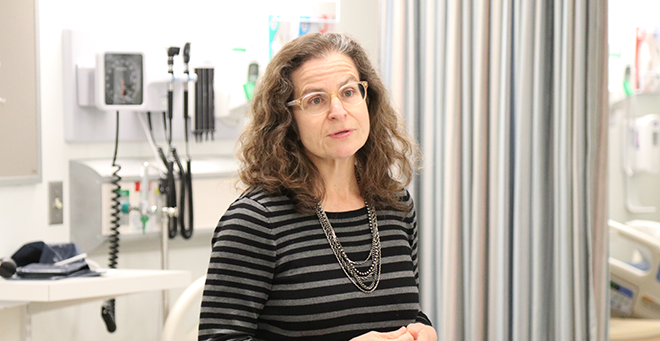An initiative to encourage bias-free learning environments across UMass Medical School is moving forward with faculty workshops, online tools and department grand rounds presentations.
DRIVE, which stands for Diversity, Representation and Inclusion for Value in Education, will improve the quality of education across the Medical School’s three graduate schools, graduate medical education and continuing education programs with self-assessment tools to root out implicit bias and new resources for bias-free education.

The initiative was born out of student concern, according to organizers.
Even before DRIVE was launched, students had challenged educators to better prepare them to work in the community with people different from themselves, said Heather-Lyn Haley, PhD, assistant professor of family medicine & community health. Dr. Haley oversees the population health clerkship, which is an opportunity for students to learn firsthand from people in the community how social determinants impact health. She is the project manager for DRIVE.
Survey data backed up students’ concerns about coursework bias. About one quarter of UMMS respondents–compared with more than 40 percent in the national average of medical schools–said School of Medicine faculty always demonstrate respect for diversity, according to the Association of American Medical Colleges 2018 graduate questionnaire.
DRIVE began two years ago to provide a critical new lens on representative learning for the institution.
Rose Schutzberg, SOM ’21, who co-founded the UMMS chapter of White Coats for Black Lives and is active in several diversity-focused committees, joined forces with the broad-based DRIVE committee to promote changes in culture across the medical school.
“It’s a moral issue for me,” said Schutzberg, who said she grew up being mentored by scientists from diverse racial backgrounds and wanted more people to have that experience.
She added, “We’re kind of fearful of those difficult conversations about diversity. So, I think DRIVE is a really good step in the right direction.”
“Everybody brings different biases to their experiences and interactions. And only by really examining and talking about those things can we understand how they might impact other people and what we can do to mitigate the negative impact,” said Melissa Fischer, MD, MEd, professor of medicine and associate dean for undergraduate medical education. Dr. Fischer is the convener of the DRIVE committee.
DRIVE begins with tools to help faculty reflect on their teaching and become more aware of bias in their educational activities and materials. A DRIVE worksheet for curriculum appraisal can be downloaded from the initiative’s webpages found within the Diversity & Inclusion Office. The appraisal tool, developed by a committee of faculty, staff and students from across UMMS, and based on resources from peer universities, asks questions about using people-first language and respectful terminology; research and references; images and media; and case studies, in its general topic areas.
Educational resources and best practices are provided on the website to help align teaching materials and the learning environment with UMMS’ values of diversity and inclusion, as highlighted in the IMPACT 2025 strategic plan.
“One of the faculty who had attended a workshop last fall reported that he found it enormously helpful,” Fischer said. “He actually made immediate changes to his teaching based on that one hour.”
Haley added, “He changed the way he taught that piece; he changed the slide; he changed the discussion that he has with students as he talks about risk factors. And that’s a great example of what we’re trying to do.”
Haley said a medical student is doing a capstone project to develop an image library of different health conditions in a wider range of skin tones, another resource for faculty and students.
“Is it a prescriptive teaching program? No, it’s really self-evaluation,” said Kenneth S. Peterson, PhD, MS, RN, FNP-BC, assistant professor of nursing and a DRIVE committee member. “If I’m going to be presenting on a clinical matter, it needs to be a presentation that includes patients from all walks of life.”
Dr. Peterson connected the conversation about diversity and inclusion in medical science education to the national discussion around racism. “I think it really helps people enter the conversation and then have strategies toward improvements,” he said.
“We need to be as transparent as we can with all our stakeholders on campus and specifically students,” he continued. “I think right now we have students who are really fired up and want to make change. And that’s why these students are in our graduate schools; because they do want to be the change agents of the future.”
Daryl Bosco, PhD, associate professor of neurology, said bias in the curriculum was not something she had “really thought about before,” when she joined the DRIVE committee.
“We talked about protein structures and DNA sequences, and how is there implicit bias in that?” she asked. “But then as I started becoming more involved with the DRIVE committee, I realized that there could be bias in our everyday lab environment. I think of how we interact with students and the choice of words we use. I think we could improve on that.”
One best practice recommended on the DRIVE curriculum appraisal tool is to share a message in teaching syllabi, course websites, a slide or statement at the start of each session that reads: “My intent is to promote an inviting and inclusive learning environment while avoiding bias. I welcome feedback.”
Fischer said that simple statement sends an important message.
“I would say it’s been a major shift for me professionally and personally,” Fischer said. “It’s not enough to practice something oneself when I have a professional responsibility to take it to the next level. And that really was part of the major impetus behind DRIVE.”
To get involved, email DRIVE@UMassMed.edu or visit the website https://www.umassmed.edu/dio/initiatives/drive/.